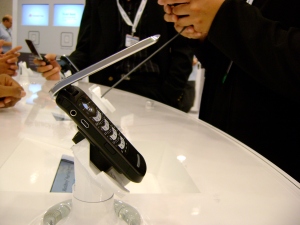In fairytales, things usually happen in threes. At CTIA 2008, I espied three trends that promise, if not a fairy tale ending, at least a major game change in the future of mobile usage in the U.S. The evidence was everywhere that the garden walls surrounding the carriers’ pick of content for mobile users is still there, but crumbling. Hastening the inevitable, broadband mobile Internet made a strong showing at CTIA, proving its inevitability. Lastly, the number of companies pitching easy ways for Internet content creators to “mobilize” their content was amazing. Since I’ve been a big proponent of all three of these directions for the mobile content market, I had a happy time at the show.
Let me just draw attention to a handful of the companies I met with and a few of the items that caught my attention. First, one of the stars of the show was RIM’s new clam-shell Blackberry Pearl 8220.

new Blackberry Pearl 8220
I’m perfectly happy with my Blackberry 8830 World Edition, but if a clam-shell Blackberry rocks your world, more power to you. And the new Blackberry does have quad-band support so it’s a world edition too.
I also had a fun time in the Yahoo booth where I got their new voice search application downloaded to my Blackbery. It’s a lot of fun to play around with, although it can’t always make sense of what I say (and that’s probably not the application’s fault), I can easily correct what appears in the browser. For the free download, go here.
QuickPlay Media is all about trying to make the mobile internet experience successful, says vp of marketing Mark Hyland. “Our CEO Wayne Purboo’s vision was that networking speeds were going to get faster and that broadband wireless would be big,” he says. “We believe that you can’t take a PC web browsing experience and cram it on to a mobile device. Mobile is very location and context specific. It makes a difference where you’re using it.”
At CTIA 2008, the company began beta-testing a brand new service for media and entertainment customers to cheaply, quickly and easily publish video to the iPhone. “And ultimately to all video-enabled devices, but we’re focusing on iPhone first because of the interest,” says Hyland. “In 5 minutes you can take existing videos in any format and create a full video site for iPhone.” This new product is expected to be released by Q4 2008; the price is not yet set.
I checked in with Nokia‘s Kamar Shah with regard to Ovi, the company’s entertainment and media sharing service, as well as the company’s future plans in the entertainment space.Once again, the mobile Internet came to the fore. “From my perspective, in the area I work in, I want to show relevance of Nokia within this market in the Internet world,” he says. “I would justify that two-fold: we’re not taking the Internet and putting it on the mobile device. We’re redefining and evolving the Internet experience. That is based on what the consumer wants. Social networking makes up 20 percent of user time – after search and mail. It’s a phenomenon. We want to take that further and make it relevant to the consumer. We also have to make the advertising relevant, we have to get it right. There’s a very low tolerance for spam on the mobile phone.”
Referring to filmmaker L.M. Kit Carson’s “Africa Diary,” which he is shooting with his N95 camera, Shah also noted that this year Nokia partnered with MTV to supply N95s to the network’s journalists for Super Tuesday; content was streamed to MTV sites. Stay tuned to MobilizedTV for more news about Nokia and the entertainment world.
UIEvolution is an answer to the cacophony of mobile’s competing operating systems, devices and networks.”Mobile phones are so fragmented in terms of operating systems,” saysKeith O’Neill, vp, business development. “The thin client technology puts a layer of frosting that gives a seamless system so you can develop on top of that without worrying that it won’t work. We can work with PCs, STBs, consumer electronics devices , and automotive audio systems.”

UIEvolution's Keith O'Neill
Fragmentation prohibits growth and innovation because it becomes cost prohibitive for content creators without deep pockets, says O’Neill, and to that end, UIEvolution is rolling out Blender, a new web developer tool and service that takes web content–text, graphics and video–and mobilizes it. The business model is based on a revenue-sharing model. The web content creator pays a set-up fee, and then splits revenue with UIEvolution, the percentage of the split depending on volume. “For all that, we host and cover all the on-going device support.”
DeviceAnywhere was another interesting destination. Any content developer worried about making the video playable on the hundreds of devices out there can do so…remotely. DeviceAnywhere is an online service that provides access to hundreds of real handsets, on live worldwide networks, remotely over the Internet for developing, testing and porting. Once again, a great solution for web creatives who want to mobilize their content without becoming computer/wireless geeks.
Thumbplay launched Thumbplay Open, says president/CEO Are Traasdahl. “It gives the ability for any content creator to sell their content to 250 million wireless users across every carrier, operating system and handset,” he says. “It’s been hard for anyone creating content to get distribution because it’s beeen very carrier controlled. “The wall is down. Now it is one big happy garden.” The challenge has bee to build a platform that works not just across handsets and operating systems but across all billing systems and video codecs. “Our system is built so it automatically detects what handsest is trying to access the content and it converts on the fly to whatever the handset requires. Our system will convert to 2,500 different handsets and it’s all seamless.”
So far, the system is launched for visual artists and musicians, but will expand to video. Click here to try it yourself.
Once the content is uploaded into Thumbplay’s system, the content creator can distribute and sell the content (the system only accepts uncopyrighted material). The system allows you to create a widget which you post to your MySpace, Facebook pages. Or you can get your own URL and sell your content from that site. “You pay nothing to put your images or music up there, although we are evaluating if there should be a fee,” says Traasdahl. “You have to pay to consume the content, either per download, which costs $1 – 3, out of which the artist gets $.50. Or you join the Thumbplay service which is $9.99 a month. Any time someone signs up for the service through the artist’s page, that artist gets $5 to 8.” (Tay Zonday of Chocolate Rain fame made $10,000 in three months but, says Traasdahl, “he’s a very smart marketer.”)
Also new from Thumbplay was the announcement of a partnership with Comcast to provide the cable MSO with mobile entertainment services include ringtones, games, video, and music.
Last but not least, I met with David Danon of SonicBoom Media, a company that launched “Name That Tune,” a mobile music game in 2003 (which has a great back-story too long for this report). The company, says Danon, is now a leader in creating “the bridge between Web 2.0 and mobile.”
“We reach out to people in their social networks, so they feel comfortable upgrading their web experience to the phone,” he says. “It’s more profound to share an experience on the mobile that your friend has sent you from the web.”
Danon is also a big believer in the future of user-generated video content on the mobile platform: and he isn’t just talking about YouTube. Speaking to that belief is the company’s product Videomaker, due out the end of the year, which allows the user to make long-form movies from 15- to 20-second clips taken with the mobile phone’s video camera. The clips are arranged along a timeline and then connected via transition effects. The result can be sent to a mobile phone as an MMS or to a website as Flash. Also on SonicBoom Media’s agenda is the Hot America mobile beauty pageant completely on cell phones. Each state will have a competition and send its winner to the national contest. This launches in late November and the first winners will be declared in Summer 2009
 entertainment.
entertainment.

 That’s true. If you type “mobile marketing” into Google, what will come up is everything from an ad agency that doesn’t have any technology all the way to Verizon and everyone in between. It’s helpful to draw ‘coarse grain segmentation’ of the marketplace. One is mobile ad networks. That’s basically doing advertising; people will sell inventory and space to take it into mobile. A second is building mobile websites, which helps people to take online properties and bring them into the mobile world. The third is around online direct marketing, or the mobile equivalent of direct marketing. That’s the category that Mozes is in. Some people call it CRM, or customer relationship management, but that means a lot of different things so I try to stay away from that term. It is about a customer community and having an engagement with them, and we do that for sure. There’s also a fourth category, which is mobile commerce or m-commerce. That’s taking your electronic storefront and bringing it into the mobile realm.
That’s true. If you type “mobile marketing” into Google, what will come up is everything from an ad agency that doesn’t have any technology all the way to Verizon and everyone in between. It’s helpful to draw ‘coarse grain segmentation’ of the marketplace. One is mobile ad networks. That’s basically doing advertising; people will sell inventory and space to take it into mobile. A second is building mobile websites, which helps people to take online properties and bring them into the mobile world. The third is around online direct marketing, or the mobile equivalent of direct marketing. That’s the category that Mozes is in. Some people call it CRM, or customer relationship management, but that means a lot of different things so I try to stay away from that term. It is about a customer community and having an engagement with them, and we do that for sure. There’s also a fourth category, which is mobile commerce or m-commerce. That’s taking your electronic storefront and bringing it into the mobile realm.














